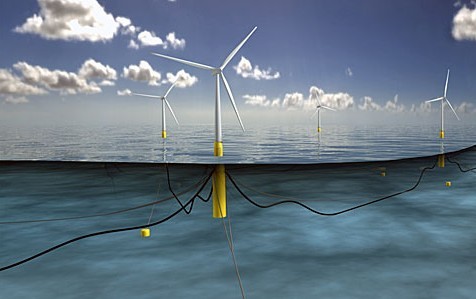
Statoil’s Hywind Park uses existing oil and gas technology combined with offshore wind construction expertise.
Each of the five turbines off the coast of Peterhead sits on a spar structure – typically used for ultra-deepwater drilling and hydrocarbon production projects.
The subsea structures, which act like floating buoys, are held in place by a series of anchor lines that attach to the seabed and hold the turbines in place.
From the top of the highest blade on the turbine to the bottom of the spar ballast is 253metres, of which 78m is under the water.
Combining this deepwater oil and gas solution with modern wind turbine technology led to the development of this world first offshore floating windfarm.
They are held in place above the seabed with three mooring lines connected to ‘suction anchors’. A motion compensation system, developed by Norway’s Statoil, keeps the turbines steady, despite the stormy surroundings.
The design allows them to be deployed in waters up to 700 metres deep according to Statoil – more than three times the depth at which current ‘fixed’ foundation turbines can be placed.
This gives greater access to high winds in offshore environments.
If the 30MW project is deemed successful it could be rolled out worldwide as a new way to harness wind power, according to Irene Rummelhoff executive vice president, for Statoil’s New Energy Solutions said: “This is project which has been in the works for nearly 15 years.
“Hywind is the first floating windfarm in the world . What we have done is taken ta traditional wind turbine on top of a substructure for an oil and gas platform called a spar.
“The idea is rather simple but the simple ones tend to be the genius ones.
“The beauty of floating compared to a traditional windfarm is that it can perform in almost all water depths. 80% of the wind resource is in water depths deeper than 60metres that are not suitab;e for ‘bottom fixed’ offshore wind.
“So we can reach an enormous amount of new wind resource. It also allows us to build bigger parks and to spread out the turbines and hence, get better wind resources.
“It basically opens every coastline in the world to offshore wind.”
Ms Rummelhoff said Scotland was the obvious choice for the Hywind pilot due to the Scottish Government’s stance on renewables which has led to a favourable legislative environment.
She added: “I think this is the start of something very exciting. We’ve seen costs come down on traditional offshore wind and we are seeing the same sort of thing on the floating side.
“We have a clear trajectory that by 2030 we do believe that floating offshore wind will be as competitive with any other technology out there to produce power.”
Recommended for you
